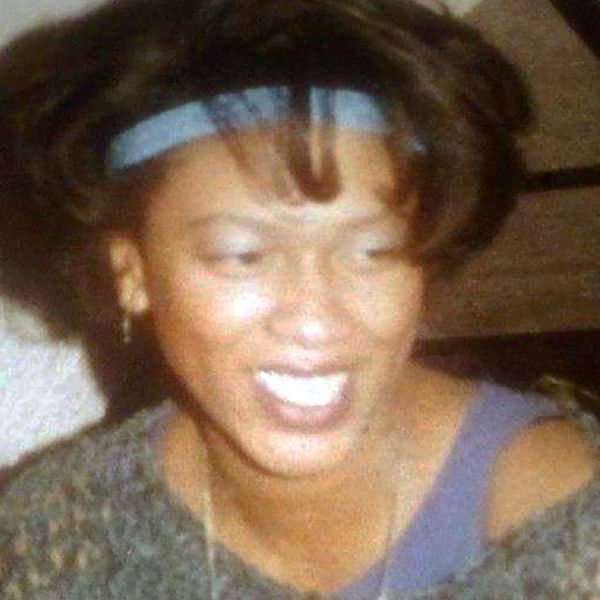Story By Robert Muldoon
One of Fredrecia Spinola’s sisters was the Connecticut Teacher of the Year. Another, a lawyer, was Corporation Counsel of Ansonia. Yet, all agree, Recia (pronounced Rica) was the most talented and brightest.
Tall and beautiful, an avid reader and artist, she scored 1300 on her SATs and was offered a scholarship to Housatonic Community College.
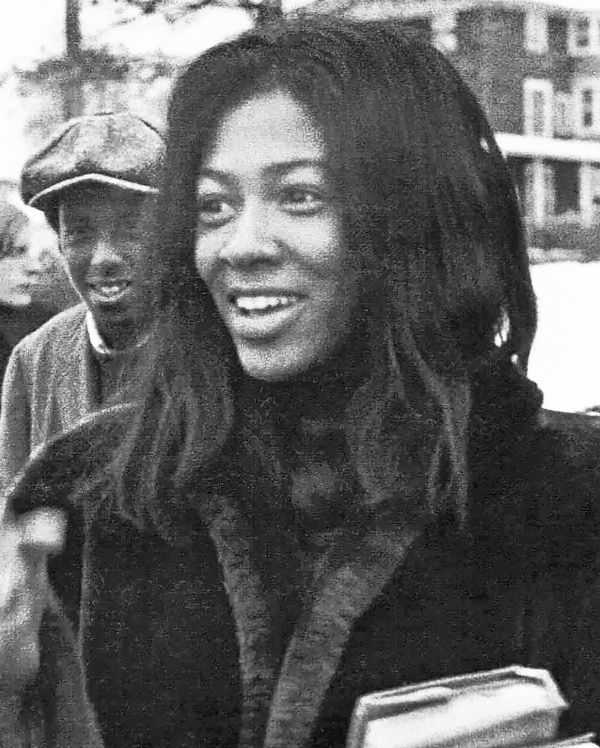
Fredrecia Spinola at Ansonia High School had a bright future. |
“She could do anything,” said Sheena Graham, the 2019 Connecticut Teacher of the Year, who carries Recia’s poems with her to this day. “She was everything you want in a big sister.”
“She was incredibly bright. She could sing and she could dance,” said Toya Graham, the lawyer.
But in 1994, Recia tumbled out of a van traveling 50 mph on Route 8, was struck by a second car, and died. The incident unfolded as the van was approaching the Campville section of Harwinton, where five other women have been found dumped near the Naugatuck River, most recently in December. All the women had drug habits, and some had a history of prostitution. Recia had arrests for both.
How did Recia, the golden girl from a high-achieving family, end up dead on Route 8 near Campville?
Recia was the eldest of six. Her father Freddy Graham was a mechanic who owned Fred’s Garage in Derby. Her mother Annie was a homemaker, who kept the books at the garage. Education was prized in the family. Annie left a book in the cribs of her children. They had to be home when the streetlights came on. When the children graduated high school, each was presented a ceramic doll made by a local woman.
Recia sang, sewed, wrote poetry and did all kinds of dance—toe, ballet, contemporary, jazz. She loved Broadway shows. Her parents attended all her events.
“We were introduced to a lot as kids,” said Sheena, 61, a high school music teacher at Warren Harding High School in Bridgeport, Connecticut. “I loved being around her. She was the apple of my eye.”

Sheena Graham still grieves her sister’s death 28 years after the Campville incident. Graham was the 2019 Connecticut Teacher of the Year. |
But around age 13, according to Toya, Recia confided that she had been raped by an uncle in New Jersey. Soon after, there was a change in the straight A student.
“She did not seem to have the confidence. She did not self-advocate. She would not stand up for herself,” said Toya, 65, the second eldest.
Sexual abuse was something not talked about in the late 1960s. Freddy and Annie were born in the 1920s. “People of those eras didn’t talk about stuff like that. They kind of pushed it under the rug,” Toya said. “But as an attorney who has worked in the child abuse and neglect area, I know that one of the reasons why a lot of women resort to drugs or prostitution is because of sexual assaults in childhood.”

Atty. Toya Graham was disappointed at the court system’s handling of her sister’s death. |
Toya and Sheena adored their big sister. All her life, Toya has cherished a music box that Recia gave her. Recia took them to musicals like Jesus Christ Superstar and The Color Purple, sharing her love for musicals. But her confidence wavered.
“She was more of a follower,” Toya said. “People influenced her. She listened to people on the streets. I’m the second oldest and Recia was very protective of me. Once we got a little older I had to protect her because she wouldn’t fight for herself. So I had to try to stand up for her. She was a good advocate for other people, but not for herself.”
Sheena cherishes Recia’s high school book of poems titled “The Me Nobody Knows.” One speaks of loneliness and solitude:
If loneliness were just my little rag doll
and understanding went as far as
Button eyes can see
then maybe I’d accept my solitude
and like a little raggedy head
I’d smile on childishly.
But thoughts that fill my head
are not of cotton.
Beneath my skin
I’m as real as Ican be.
A 1972 graduate of Ansonia High, Recia was in the drama club and the glee club. Prejudice was her biggest dislike, said the yearbook. Afterward high school she worked at St. Mary’s Hospital in Waterbury. Looking back, Toya said “Recia did not understand her gifts.”
She met Roy Spinola, of Waterbury’s Cape Verdean community. Recia was a mix of African-American, Cherokee and white—with long, dark hair that may have owed to her Native heritage. The two married. After suffering some miscarriages, Recia had a daughter she named Jillian in 1985.
One time Toya recalled Roy burst out laughing when Recia wanted to go to the library. “They came from two very different worlds,” she said. “There was not a lot in common.”
Eventually she tumbled into the world of drugs. With money tight, Recia began hustling on the streets of Waterbury to support her habit. By January 1993, she was seeing Jillian sporadically, struggling with addiction.
On January 9, 1993, days after a third Waterbury sex worker had been murdered and dumped in Campville, two journalists went to the corner of Willow and Grove Streets to investigate. There they met Recia, dressed in white boots, leather jacket, and pinstripe pants.
Recia knew two of the murdered women, she told the reporters, including one murdered only three days earlier, Evelyn Bettancourt, known by the street alias “Lisa.” She also knew Mary Jo Markiewicz, dumped on Waterbury train tracks, six weeks before that.
On this night, with death hanging in the air, police alerted women to beware of “a white man in a van,” a possible serial killer. But Recia was unafraid. Cops warned her to get off the streets, where she stood defiantly.
“I got me a habit and I’m going to stay out until I die,” she prophesied.
The journalists met other women that night who told stories similar to Recia’s—doing sex work to pay for drugs. But Recia was different.
The others used aliases. The others admitted fear. The others were discreet.
Not Recia.
She gave her full name: Fredrecia Spinola; her age: 38; said she had an 8-year-old daughter; spoke frankly about struggles with drugs—and she agreed to be photographed.
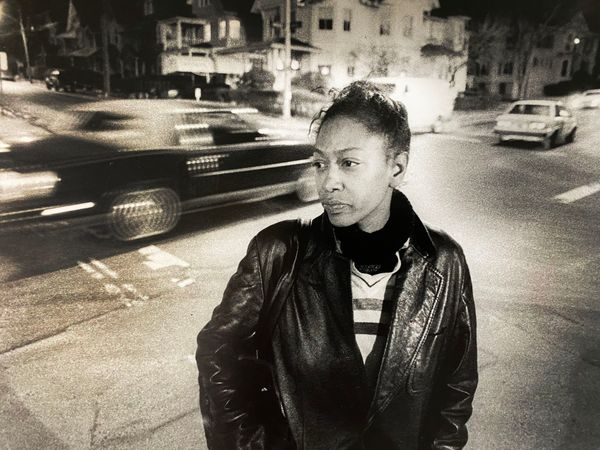
Fredrecia Spinola on January 6th, 1993 on Grove Street in Waterbury. |
When one reporter asked, “If I told you I was the killer, and offered you $20, would you get in the car with me?”, Recia didn’t skip a beat.
“I would,” she said, looking him up and down. “You don’t look like a killer to me.”
It was a chilling encounter, sending shivers down both reporters’ spines.
Was it bravado? Gallows humor? Recklessness? Maybe. But it was also charisma.
The reporters talked with Recia just a few minutes and never forgot her. The other four women they talked to have long since faded from memory.
At 38—and she didn’t lie—Recia looked good, but she had seen better days.
“There used to be a line for me, but I’ve lost weight,” she said, flashing a hint of pride, as cars circled Willow and Grove, eyeing her.
Recia was addicted to p-dope, a synthetic heroin that she shot into her arms, legs or feet. She also used crack cocaine. Crack got her up; p-dope brought her down.
“We must do both, we’re all junkies,” she said, not shading the truth.
The men in the cars paid her $20, the amount for a bag of p-dope, or two hits of crack.
Without p-dope, she got sick.
“Dope sick,” she called it. “You throw up and have diarrhea. You don’t care about AIDS. You’re sick.”
You also don’t care about serial killers.
Two years later, Fredrecia Spinola, 40, of Waterbury, “fell or jumped” from a van traveling 50 mph on Route 8 approaching Harwinton. She was hit by a second vehicle and died on the road of multiple, blunt force trauma.
Recia was driving with “a white man in a van,” a stone’s toss from where three other women had already been dumped, off Route 8 in the Campville section of Harwinton. The driver, Albert S. Boyson, 77, told police that Recia had entered the van at MacDonald’s, on Thomaston Avenue, in Waterbury. He was en route to drop the GMC passenger van off at Kelley Transit in Torrington, where he was a driver, he told police.
News accounts the following days described Recia as “a recovering drug addict and prostitute from Waterbury.” Sergeant William Longo, the on-scene investigator, said: “According to the driver (Boyson), she gave no indication whatsoever that she was going to jump, and I don’t have any reason not to believe him.”
Boyson was not considered a suspect by the Connecticut State Police. “The possibility of him ejecting her is physically remote,” Longo concluded.
Police quickly pivoted and sought the driver of the second vehicle. After recovering a part of that car from Recia’s body, police identified the make and model as an Audi.
“Even if she had been dead in the road and he hit her, he’s obligated to stop,” spokesman Sergeant Scott O’Mara said as police now sought the second driver. Still, police were puzzled, “why Spinola wanted to go to Torrington or if she even understood where she was going.”
Boyson claimed she seemed disoriented on drugs: “Spinola muttered something about the town of Harwinton just after the van passed a sign announcing the Harwinton exit,” Boyson said. Earlier she had been “freaking out,” he said. She jumped out of the van at 50 mph in a dark, foggy section of the road in a sleet storm on December 9, 1994, he said.
Harwinton was where Karen Everett, Mildred Alvarado, and later Jessica Muskus and Brianna Beam were dumped. Boyson dragged Recia’s body out of the traffic lane, he said.
“The physical evidence gathered so far seems to indicate that she was either trying to stand up or crawl away when she was hit by a second car,” police said. The investigation quickly focused on a possible malfunction of the door and finding the driver who struck her, and did not stop.
The driver of the second vehicle, Andrew F. Keene Jr, 53, of Cheshire, turned himself in days later, charged with “evading responsibility and negligent homicide.” He told police that he thought he’d hit a deer.
Boyson was released that night and and was back driving the white van for Kelley Transit the next day. His 2006 obituary noted he was an assistant scoutmaster and a constable in Newtown for years. At his death Boyson was surrounded by his family.
Jillian Spinola was 10 when her mother died. That night, in her grief, she sent a letter to her mother in “Heaven” lamenting that “I never really had a chance to say how much I love you. And now I miss you so much. I never let you call me baby, but now that you’re gone, I don’t care. Mom I love you. Please BE HAPPY.” It was signed “Jillian, Your Baby.”
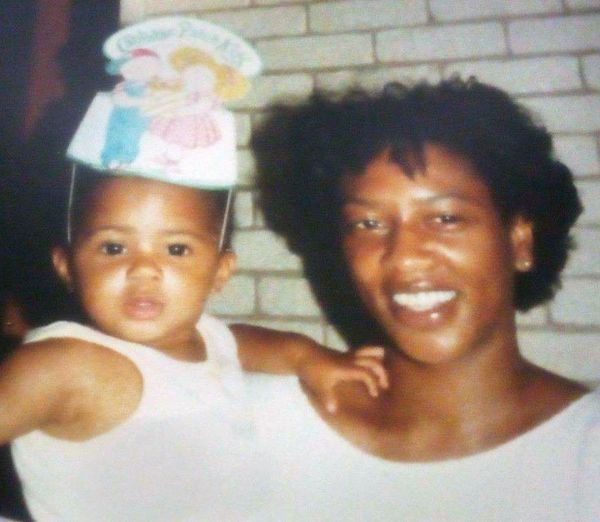
Fredrecia Spinola and her daughter Jillian celebrating a birthday in the 1980s. |
Recia had taught Jillian to make quiche, her favorite food. She often took a cab to visit Jillian, and they went for walks. Delicate and sensitive, Recia often hid behind a façade, Jillian said.
“She loved reading, cooking, fashion, clothes, helping other women. She loved animals and she loved me,” Jillian said. “My mom liked to kiss my toes, sorry, but she did.”
Jillian had many questions about her mother’s death. At 16, she went to the library to read the newspaper microfiche stories. She wanted to reach out to Boyson, the van driver, and Keene, the driver who struck her after she exited the van. But she was too young, too frightened. She compartmentalized her pain.
Jillian had resentment. She acted out with boys. She put the letter to her mom in the corner of her mirror. She kept her mother’s photo in her lunch box. She struggled. How can a circle hold when the center is gone?
At 12, she stopped working in school, isolated from friends. She stayed with her Auntie Evelyn (Roy’s sister) in Waterbury. This hurt Sheena, Recia’s sister, who wanted custody, but lived in Ansonia and taught in Bridgeport. Jillian wanted to stay in Waterbury.
“And Jillian could sing, oh my gosh and I’m a music teacher,” Sheena said.
At Wallace Middle School Jillian attended a summer program for the gifted. Mr. Sullivan, the principal, believed in her. His belief ignited something inside her and she began doing school work again.
At 18, Jillian married. Her oldest daughter, 16, is in the Kennedy High School SOAR program, takes all Advanced Placement classes, builds robots, and won a talent show. “She reminds me of her, very smart,” Jillian said. “She’s already being chased by colleges.”

Jillian Spinola thinks about her mother every day. |
Jillian’s youngest is 10 and has neurofibromatosis type two. She gets benign tumors on her spine and brain. “She’s a tough kid and reminds me of my mom in other ways,” Jillian said. She’s very gentle, sweet, kind, and feminine like my mother was.”
Life has its struggles. Recia had told Jillian to never get bitter or jaded—no matter how hard life became. Jillian tries to hold on to those words now as a single parent, and she fights on.
Toya has never believed the police account of Recia’s death. “She was a survivor. I knew she was using drugs, but she was incredibly smart. Her mind was intact, and I just don’t see her jumping out of a car unless there was a reason, or she’s trying to get away from someone, or somebody pushed her out of the car.”
Sheena has her own theories and believes the driver of the van needed to be looked at a lot harder, and might have been responsible for all the bodies being dumped in Campville. “When she saw a sign that said Harwinton she might of thought he was the murderer, and she was getting up out of there.”
Toya, an attorney, wanted updates on the case against the second driver. She contacted the State Attorney’s Office to be kept in the loop, but did not find out until after the fact that Keene had accepted a plea deal and served no time.
“I felt no one cared about her and we loved her,” Toya said. “She was a wonderful person. I felt the whole situation was handled poorly. I was really upset about that.”
There are many unanswered questions:
• What was Fredrecia doing in the van?
• Was she alive when she exited?
• Why would she fall or jump?
• Was she pushed?
• Were tests conducted to confirm the driver’s statements?
The Waterbury Observer has filed several Freedom of Information requests with the Connecticut State Police to obtain police records of the investigation into Recia’s death, and the newspaper was informed it could take up to a year to secure the documents.
Toya would like to see the case looked at again. “Even if the person is no longer alive, I want to know what happened to my sister. I just want to know it. I want to know what happened.”
Sheena keeps Recia’s book of poems. Toya has the music box and memories of the musicals they loved so much.
Fredrecia Graham Spinola is buried in Ansonia beside her parents, Fred and Annie. Jillian would like Recia to have her own stone someday. A special place to remember her—with her picture.
Until then, Jillian holds on to the letter she sent to “Heaven” right after her mother died. The letter is crumbled and stained, but it’s a daily reminder of her mother who she loved.
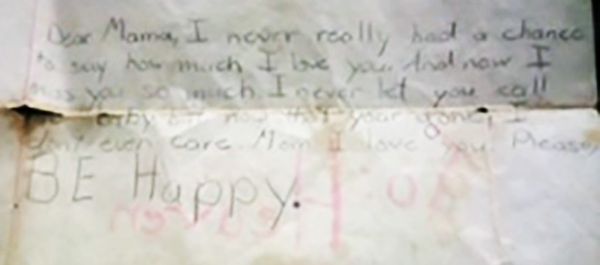 |

